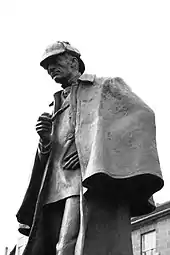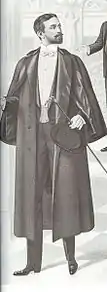Inverness cape
The Inverness cape is a form of weatherproof outer-coat. It is notable for being sleeveless, the arms emerging from armscyes beneath a cape (the sleeved version is an Inverness coat; the shorter-caped, sleeved version is an Ulster coat).
The Inverness cape is a water-repellent garment. The extra layer of cloth at the shoulders traditionally hindered rain from soaking through the wool.
History
.jpg.webp)

The garment began in the 1850s[1] as the Inverness coat, an outer coat with sleeves covered by a long cape, reaching the length of the sleeve.[lower-roman 1] By the 1870s, the cape was divided in two, and a small "capelet"-like "wing" on each side was sewn into the side seams, not taken across the back.[2] In the 1880s, the sleeves were removed entirely, leaving only the armholes beneath the cape, to form the Inverness cape.[2][3]
The fronts of the coat may be finished in either of two styles: in one, the more formal, the topcoat is finished with short lapels and the capes are set back behind them.[4] In another style, there are no lapels. A simple fall collar with a tall stand is used, the capes buttoning across.[5] These were also favored for less formal wear, particularly by coachmen and cab drivers, who needed free movement of their arms. Indeed, this style is usually called a "coachman's cape."
Still worn in the United Kingdom, the Inverness cape is often made of heavy Harris tweed of plaid and checked designs. The commonly held image of the cape as worn by Holmes is one made of tweed, specifically in a grey hound's tooth pattern. It is usually worn for country wear. Lighter-weight black cape-coats are associated with formal evening attire. Modest capes, made of Gore-Tex, nylon, or twill-weave fabrics and usually black, are commonly used by members of pipe bands.
Highland dress

Even though a wide variety of coats, overcoats, and rain gear are worn with Highland dress to deal with inclement weather, the Inverness cape has come to be almost universally adopted for rainy weather by pipe bands the world over, and many other kilt wearers also find it to be the preferable garment for such conditions. Unlike most raincoats or other conventional overcoats, the Inverness cape has no sleeves. Instead, it has wide-cut armholes in the sides to accommodate the arms. This enables the wearer to access a sporran without unbuttoning and opening up the cape. The opening in the side is covered by a short cape, which can be buttoned up in the front.
In popular culture


Arguably the most famous example in fiction, Arthur Conan Doyle's famous detective Sherlock Holmes is often associated with the Inverness cape.[3] However, in the novels, Holmes is described as wearing an Ulster.[6] Holmes's distinctive look, which was usually complemented with a deerstalker cap and a calabash pipe, is a composite of images, originally credited to a series of illustrators including David Henry Friston[7] and Sidney Paget.[8] But as adapted to the stage by the actor-playwright William Gillette,[9] Holmes did not wear a cape-coat at all, and the origin of the calabash pipe is something of a mystery, although it might have had something to do with Gillette's introduction of a full-bend briar pipe for his performances. Paget had depicted Holmes as smoking straight pipes, exclusively.
Friston, who illustrated the first published Sherlock Holmes novel of A Study in Scarlet, portrayed the character in a deerstalker-like hat and an elongated trench coat.[10]
Be that as it might, the cape-coat, the deerstalker, and the calabash pipe were already associated with Holmes by the 1930s, chiefly in the United States, but the image became definitive with the first two films in which Basil Rathbone appeared on-screen as Holmes, produced for 20th Century Fox in 1939.[lower-roman 2]
August Derleth's Solar Pons, essentially Sherlock Holmes with a different name and living in Praed Street in the 1920s, also wears an Inverness.[11]
Inverness capes are worn by characters in many Western and Spaghetti Western films, such as Lee Van Cleef's character in For a Few Dollars More and Gianni Garko in the Sartana series.
In the 1970s of the long-running series Doctor Who, the Third Doctor (Jon Pertwee), frequently wore an Inverness cape over his dandy suits. Pertwee took credit for the Doctor's Edwardian appearance himself, having taken an Inverness cape from his own grandfather's wardrobe to complete the costume.[12]
The vampire Barnabas Collins (as portrayed by actor Jonathan Frid) wore an Inverness cape on the 1966 cult classic Gothic soap opera Dark Shadows. The Inverness cape made a reappearance in the 2012 Tim Burton film remake, Dark Shadows (film). Costume designer Collen Atwood took inspiration from the original series, but "didn't want to do a boring black coat," so opted to update the costume with a "bottle-green fabric."[13]
The 2001 film adaptation of the absurdist play Waiting for Godot has landlord Pozzo (played by Alan Stanford) wearing an Inverness cape, symbolising the Protestant Ascendancy landlords of Ireland.
Popular urban fantasy hero Harry Dresden of The Dresden Files by Jim Butcher replaced his trademark duster with an Inverness coat in Cold Days, the 14th book of the series.
Steampunk fashion has revived the wearing of the Inverness cape to a limited extent.[3]
Japanese version of the Inverness coat
_in_Japan%252C_Taisho_era_(1914_by_Elstner_Hilton).jpg.webp)
The Inverness coat was introduced into Japan during the Meiji era, and its modified version, the tonbi or tombi ( とんび ) coat, gained a lot of popularity.[14][15] At that time, there were many kinds of modified Western coats, and the tonbi was an example.[14] The coat style was called tonbi, because the flaps on either side of the shoulders looked similar to that of a kite.[14] The tonbi could be worn over a kimono, and this was a reason for its popularity.[14] Historically, the use of wool was limited in Japan until the Meiji era, however the increased demand for new overcoats which could be worn over the kimono, including the tonbi, ignited the market.[16] The tonbi remained in common use as an overcoat worn by men during the Meiji, Taishō and Shōwa eras.[15][17]
See also
References
- In comparison, the Ulster coat is similar, but the cape of an Ulster reaches only to the elbows.
- In the Holmes short stories that were published in The Strand Magazine, Paget had depicted Holmes wearing a plaid Ulster, paired with a Bowler, not the deerstalker, in "The Musgrave Ritual" and "The Blue Carbuncle." In the text of "The Adventure of Silver Blaze" and "The Boscombe Valley Mystery", Holmes is not described as wearing an Inverness but a "long grey travelling cloak" depicted by Paget as an overcoat with a hood. See File:Sherlock Holmes Paget.jpg
- Waugh, Norah (1964). The Cut of Men's Clothes. p. 143. ISBN 1138870552.
- Davis, R.I. (1994). "Topcoats". Inverness caped topcoat. Men's Garments: 1830-1900 (2nd ed.). Players Press. pp. 122, 140–143. ISBN 0-88734-648-0.
- "1850s-1900s Inverness or "Sherlock" Cape". Patterns for Historical Clothing. Reconstructing History. RH940. Archived from the original on 2021-04-16. Retrieved 2017-11-30.
- Davis, Men's Garments, p. 140, fig. 29
- The Delineator. October 1892.
{{cite journal}}: CS1 maint: untitled periodical (link) - Chrisman-Campbell, Kimberly (2014-10-27). "Sherlock Holmes, Unlikely Style Icon". The Atlantic. Retrieved 2021-02-16.
- "Highlands Fashion Week's Sherlock Holmes cape crusade". BBC News. 2014-11-01. Retrieved 2021-02-26.
- "The world-wide fascination in Sherlock Holmes' tweed cape". BBC News. 2014-11-05. Retrieved 2021-02-26.
- "William Gillette: Five ways he transformed how Sherlock Holmes looks and talks". BBC News. 2015-01-26. Retrieved 2021-02-16.
- "Sherlock Holmes cape to get modern fashion revamp". www.scotsman.com. Retrieved 2021-02-26.
- Derleth, August (1974). Regarding Sherlock Holmes... #1/The Adventures of Solar Pons. New York, N.Y.: Pinnacle Books. p. 185. ISBN 0-523-00477-X.
- Fordy, Tom (2020-01-02). "The most delightfully English Doctor of all: how Jon Pertwee brought panache to Who". The Telegraph. ISSN 0307-1235. Retrieved 2021-03-04.
- "'Dark Shadows' Costume Designer Colleen Atwood on Johnny Depp's 'Rock Star' Duds". The Hollywood Reporter. 2012-05-10. Retrieved 2021-03-04.
- Ishikawa, Takuboku (2011). Romaji Diary and Sad Toys. Translated by Sanford Goldstein, Seishi Shinoda. Tuttle Publishing. ISBN 9781462900787.
- "Coats for the male Kimono wearer". 2019-07-12. Retrieved 2021-03-08.
- Milhaupt, Terry Satsuki (2014). Kimono: A Modern History. Reaktion Books. ISBN 9781780233178.
- Kaikoku Hyakunen Kinen Bunka Jigyōkai (Japan) (1969). Japanese Culture in the Meiji Era. Vol. 5. Toyo Bunko. p. 43.


